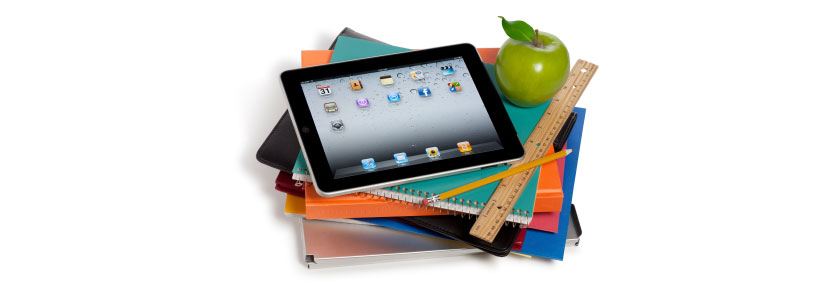Kids these days tend to love technology, especially handheld mobile devices that play movies, games, and apps for learning and entertainment. It seems that so many children these days are learning from apps, sometimes even more often than they learn from books. And while some may laud this as a positive trend, there are downsides. Specifically, experts worry about kids that don’t have access to mobile devices with apps, and are concerned that their learning experiences may not be as rich as those who do regularly use mobile devices. This learning lag is what’s know as the “app gap,” the difference between the education of kids who can afford iPhones, and kids who can’t. But at the same time, apps and screen time may not be doing affluent children any favors. Sure, they teach motor skills, words, math, and even foreign languages, but the official word thus far is that they’re not actually helpful, and spending too much time engaged with a screen, whether it’s a TV, computer, or iPad, can actually be harmful to child development and learning. Read on, and we’ll take a look at facts about the app gap, screen time for children, and technology in education at large.

- Affluent families are far more likely to download specialty apps for kids
Although apps on mobile devices can be educational for children, not all kids have access to them, and typically, low income children are left out. In families with incomes over $75,000, almost half of them download apps for their young children, but in lower-earning families with incomes of $30,000 or less, only one in eight downloaded apps. That means low income children may be missing out on educational resources that might help them in the future. Some schools are adopting iPads and other mobile devices for learning, but they are not yet prevalent, leaving students without the means for mobile learning in the dark.
- The American Academy of Pediatrics does not recommend apps for young children
Experts and parents worry about the possibility of low income students being left behind while rich kids learn from their iPads, but this disparity may actually be doing them a favor. Although parents are often quick to hand over their iDevices on demand, the AAP recommends that children under the age of two do not experience any “screen time.” This includes iPhones, iPads, and other devices, even if they do offer educational apps. According to the AAP, children over the age of two should not have more than one to two hours of screen time each day, and it should be broken up into half hour intervals.
- Many low-income parents don’t even know what an app is
For many moderate to high income parents and kids, apps are a fact of daily life, whether they are for email, entertainment, or learning. But in lower income brackets, apps are a mystery that both parents and kids are clueless about. In a recent study, more than a third of low-income parents did not know what an “app” was. For kids, this means that they can’t benefit from something their parents aren’t even aware of.
- There’s a gap between screen time and reading in young children
Screen time, whether it’s from mobile devices, computers, or TV all adds up throughout the day. And although some of this time may be touted and accepted by many as educational, in practice it’s often taking the place of a more valuable learning tool: reading. Screen media use in children often dwarfs that of reading time. Even in infants and toddlers, kids typically spend over twice as much time watching DVDs and TV as they do being read to or reading independently.
- The iPad has been called “Children’s Toy of the Year”
The iPad is so popular for kids in entertainment, learning, and let’s face it: distraction, PC World once referred to it as the “Children’s Toy of the Year.” The magazine highlighted how naturally kids seem to gravitate to the iPhone and iPad user interface, and somehow immediately know what to do with it. That means it has the potential to be a great tool for educational learning, giving kids an attractive toy to play with and learn from. And as PC World has pointed out, it’s a substitute for DVD entertainment in cars, as kids can change apps and watch movies independently, a use that’s perhaps more developmentally beneficial than watching TV.
- App use is not as prevalent as you might think
News articles and YouTube videos might have you believe that practically every kid in the developed world is walking around with their own mobile device in their pockets. And although parents (and kids) are increasingly adopting iPhones and iPads, statistics indicate that their use may not be as widespread as it seems. Or at least, kids aren’t using them day in and day out. Each day, just 11% of 0-eight-year-olds use a smartphone, iPod or similar device for apps, games, videos, and entertainment. And even when they’re doing so, they don’t actually spend that much time doing it, with the average amount of usage time coming in at 43 minutes a day.

- Some parents may not be paying attention to what their kids are doing on their iPhones
Aside from the obvious cost to own an iPhone and maintain a data plan, there may be another reason low income parents don’t typically download apps for their kids: the hidden cost. Parents may not be paying a lot of attention to the apps they’re downloading for kids, and without careful supervision (or disconnection from a data plan or WiFi), kids can rack up hundreds, even thousands of charges from the app store and even in-app purchases. One article from MSNBC highlights the stories of boys who “$52 buying virtual coins to play with dolphins in an iPhone game,” and a young girl who ran up a whopping $1,400 bill on iTunes for “Smurfberries.” The parents of these children had no idea the purchases were made until they noticed them on their credit card statements.
- More kids have mobile devices than ever before
Although the American Academy of Pediatrics does not recommend regular screen time for children, young kids are spending more time than ever in front of screens. And although TV makes up a lot of that time, mobile devices do to. In fact, according to studies, half of children under eight have access to a mobile device, including iPods, iPads, and iPhones.
- Doctors aren’t talking about screen time with parents
Mobile device use and apps are prevalent, and although they’re certainly coming up as a topic of discussion in mom groups, it doesn’t seem like it’s coming up in doctor’s offices. In fact, reports indicate that just 14% of doctors have ever discussed media use with parents of children two and younger.
- Children now are more likely to own a mobile phone than a book
Although some apps include books gone interactive, it seems like mobile devices and their apps may be replacing books as handheld entertainment for children. In a study by the National Literacy Trust, it was shown that nearly nine in ten students have a mobile phone, but less than 75% of kids have their won books at home. While apps may be educational, they can’t take the place of books, and parents would do well to either provide books or visit the library to get books for kids to read in place of using apps.
- Older kids typically prefer digital distractions over books
The iPhone has only been around since 2007, not long enough to have an incredible impact on the development of older kids from birth. But still, even in older childhood, digital distractions are increasingly popular for kids. And although phones with apps and even computers can be educational, they’re not always used that way, much to the detriment of students’ education. In a New York Times article, one student was only able to finish 43 pages of a summer reading assignment, one that he should have finished in less than two months, but instead preferring to “get a whole story in six minutes” from YouTube.
- Low income kids do often have access to computers, however
Although some worry about the app gap leaving low income students behind as higher income students are able to learn and play on the go, the fact is that digital learning resources are typically available to most students who want them. Schools may not be full of iPads for every student, but most children do have access to a computer at home, often at home: 72% of children eight and under have a computer they can use at home, including 48% of low income families. Educational computer games, apps, and learning websites can be utilized on computers as well as mobile devices, so the app gap may not be as worrisome as it seems.
- Kids frequently use computers
Even as mobile device use grows, computers remain a popular device for children. For the average child, computer use begins around age three, earlier than even public school. And although kids that age may not be using a computer every day, that number grows with age. At ages two to four, about 12% of kids used a computer each day, and 24% used a computer at least once a week. By age five to eight, 22% of kids typically use a computer each day.
- Most iPhone moms will let their kids use them
It’s not surprising that lots of parents with iPhones allow their children to play with them. Most kids recognize the phone as a fun toy and will often demand or simply take it to play with, even if parents are a little wary about handing over an expensive piece of hardware to a tiny master of destruction. In fact, more than 59% of US moms with iPhones will let their children use the device, and of these, 61% with download apps, games, and other entertainment just for their kids to use.
- There are far more important gaps to worry about
The app gap, and its possible result of disparity of education between kids who have apps, and those who don’t, is a seemingly small inequality that may or may not have any merit at all. Educational DVDs, computer programs, and apps may be helpful, or they may not, and they all add up to screen time, which the American Academy of Pediatrics does not recommend for children under the age of two, and recommends limited use for older kids. Still, poor children have much more to worry about, including gaps in nutrition, health care, and even availability the simplest of electronic learning devices, all of which can affect achievement much more than the latest iPhone game for kids.
No comments:
Post a Comment